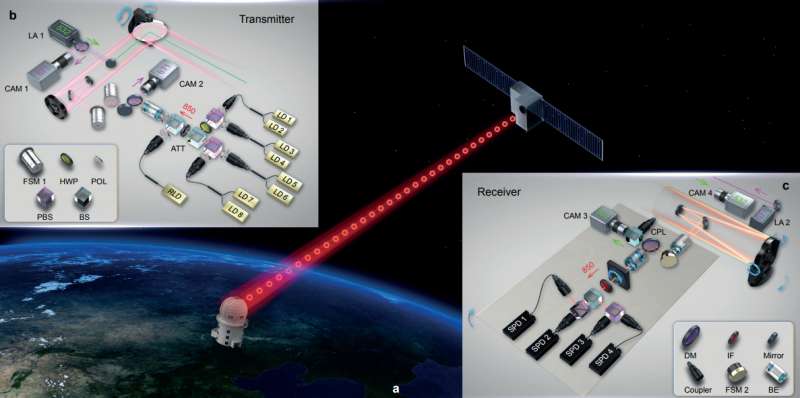Illustration of the experimental set-up in the 1st paper. Credit: Nature (2017). DOI: 10.1038/nature23655
(Phys.org)—Two Chinese teams working with quantum encryption and entanglement have achieved two more goals toward building a quantum space-based communication network. In the first experiment, one team succeeded in sending quantum keys from a satellite to two ground stations. In the second, another team sent entangled photons from the ground to a satellite. Both teams were made up of researchers from several institutions in China and both have published their results in the journal Nature.
Quantum-based networks have been proposed as the next innovation for both speeding up and sending more information through communications networks—to that end, teams in countries such as Japan, the U.S. and China have been working hard to better understand how to actually create them. Most in the field agree that national, international and global quantum networks will require data to be sent at least partially via satellites because traditional media such as fiber cable results in too much interference and data loss. Quantum networks are also theorized to be hack-proof because observing the keys that are used to unlock the data would destroy them due to their quantum nature. In this new effort, the two research teams have fulfilled the second and third goals (the first was to break the distance record for sending entangled particles and was achieved this past June) outlined by officials directing that country's Quantum Experiments at Space Scale project, which involves making use of the Micius satellite—the first sent aloft to conduct quantum networking experiments.
The first team reports that they have successfully transmitted multiple quantum keys from the satellite to two ground-based stations in China—one in Xinglong the other in Nanshan. The distance involved was between 645 and 1,200 kilometers. The main result of the experiment was proving that it could be done.
The second team reported that they successfully sent entangled particles from ground stations in China to the satellite, complementing their experiments in June, in which the process was reversed.
In achieving their goals, the Chinese researchers have moved to the forefront of quantum-based network communications and have demonstrated that the country's leaders are serious about implementing the first global quantum system over the course of the next decade.
More information: 1. Sheng-Kai Liao et al. Satellite-to-ground quantum key distribution, Nature (2017). DOI: 10.1038/nature23655
Abstract
Quantum key distribution (QKD) uses individual light quanta in quantum superposition states to guarantee unconditional communication security between distant parties. In practice, the achievable distance for QKD has been limited to a few hundred kilometres, owing to the channel loss of fibers or terrestrial free space that exponentially reduced the photon rate. Satellite-based QKD promises to establish a global-scale quantum network by exploiting the negligible photon loss and decoherence in the empty out space. Here we develop and launch a low-Earth-orbit satellite to implement decoy-state QKD with over kHz key rate from the satellite to ground over a distance of up to 1,200 km, which is up to 20 orders of magnitudes more efficient than that expected using an optical fiber (with 0.2 dB/km loss) of the same length. The establishment of a reliable and efficient space-to-ground link for faithful quantum state transmission paves the way to global-scale quantum networks.
2. Ji-Gang Ren et al. Ground-to-satellite quantum teleportation, Nature (2017). DOI: 10.1038/nature23675
Abstract
An arbitrary unknown quantum state cannot be precisely measured or perfectly replicated1. However, quantum teleportation allows faithful transfer of unknown quantum states from one object to another over long distance, without physical travelling of the object itself. Long-distance teleportation has been recognized as a fundamental element in protocols such as large-scale quantum networks and distributed quantum computation5,6. However, the previous teleportation experiments between distant locations were limited to a distance of the order of 100 kilometers, owing to photon loss in optical fibres or terrestrial free-space channels. An outstanding open challenge for a global-scale 'quantum internet' is to significantly extend the range for teleportation. A promising solution to this problem is exploiting satellite platform and space-based link, which can conveniently connect two remote points on the Earth with greatly reduced channel loss because most of the photons' propagation path is in empty space. Here we report the first quantum teleportation of independent single-photon qubits from a ground observatory to a low-Earth-orbit satellite—through an up-link channel—with a distance of up to 1,400 km. To optimize the link efficiency and overcome the atmospheric turbulence in the up-link, a series of techniques are developed, including a compact ultra-bright source of multi-photon entanglement, narrow beam divergence, high-bandwidth and high-accuracy acquiring, pointing and tracking (APT). We demonstrate successful quantum teleportation for six input states in mutually unbiased bases with an average fidelity of 0.80 ± 0.01, well above the classical limit. This work establishes the first ground-to-satellite up-link for faithful and ultra-long-distance quantum teleportation, an essential step towards global-scale quantum internet.
Journal information: Nature
© 2017 Phys.org
























